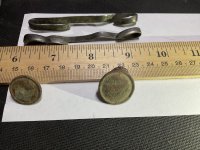CWnut
Hero Member
- May 9, 2003
- 591
- 37
- Detector(s) used
- Tesoro tigershark----Tesoro Conquistador Umax------Fisher FX-3----Master Hunter CX-Plus w/ depth multiplier
- Primary Interest:
- All Treasure Hunting
did anyone else besides me notice that a 02:47 the hammer had suddenly changed to the left side?



 . The western frontier started at the Ohio River, and there were several expeditions that ended in bloody battles, the early pioneers and settlers were constantly being attacked. These early Indian Wars instilled alot of fear in the Indian tribes, especially the ones that had been driven west. Fear of the US Government retaliating may have also played a big role. But I think the Indians mainly saw them as friendly White Men, that were willing to trade.
. The western frontier started at the Ohio River, and there were several expeditions that ended in bloody battles, the early pioneers and settlers were constantly being attacked. These early Indian Wars instilled alot of fear in the Indian tribes, especially the ones that had been driven west. Fear of the US Government retaliating may have also played a big role. But I think the Indians mainly saw them as friendly White Men, that were willing to trade.
